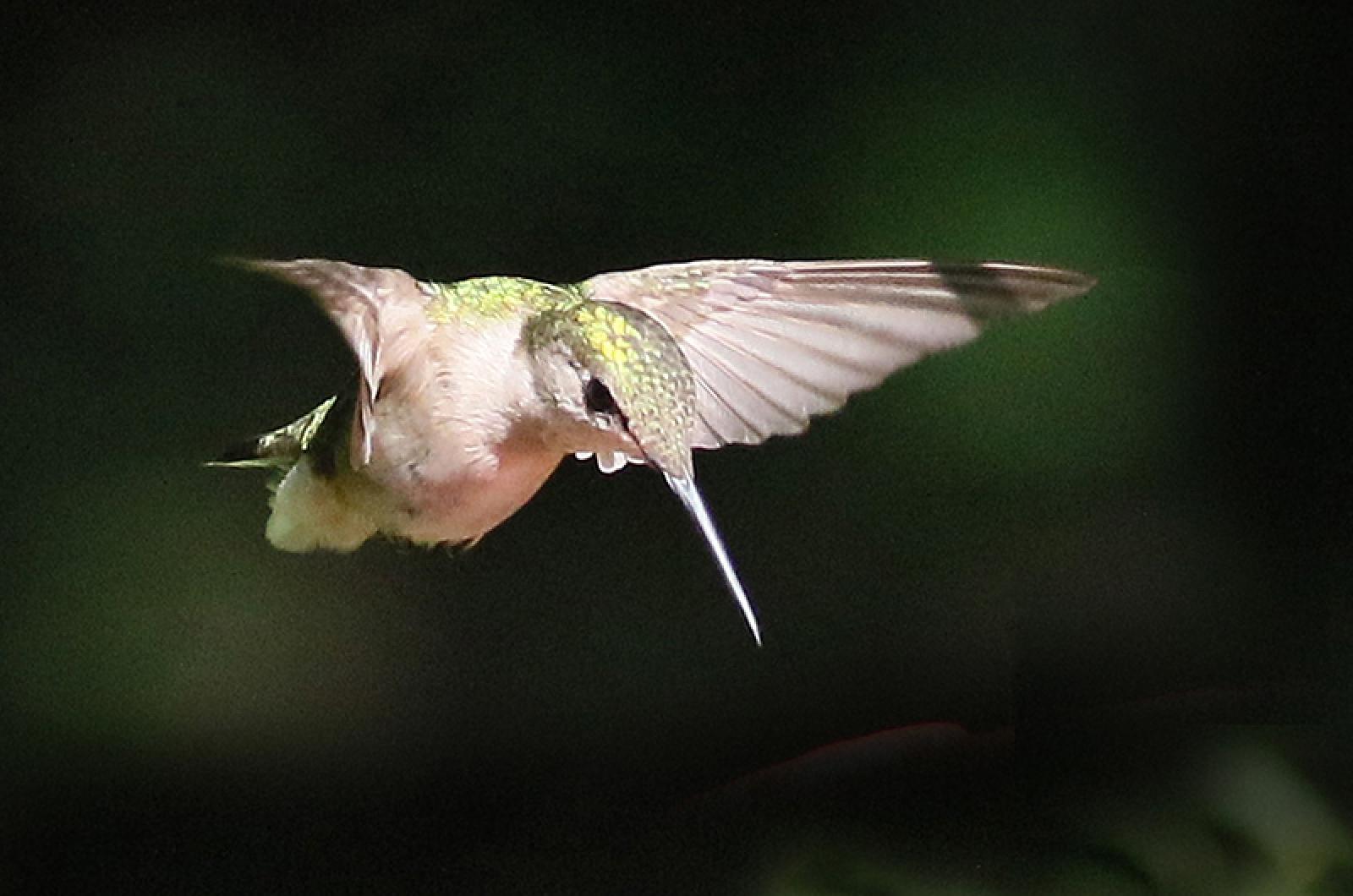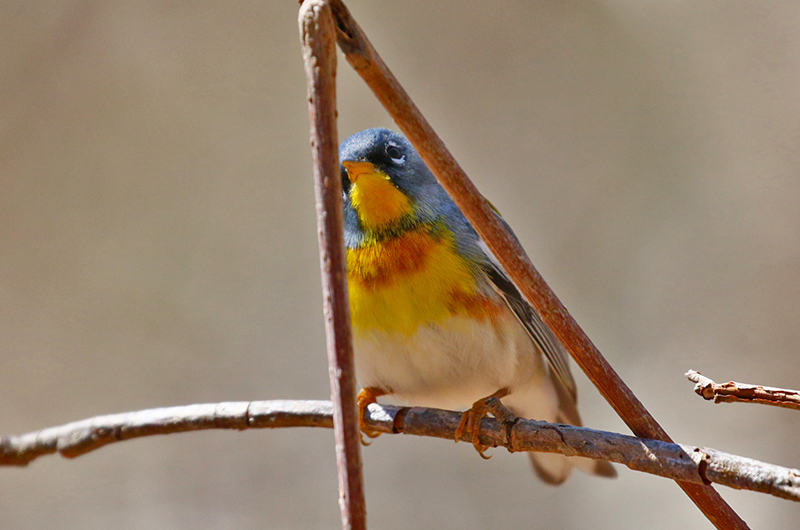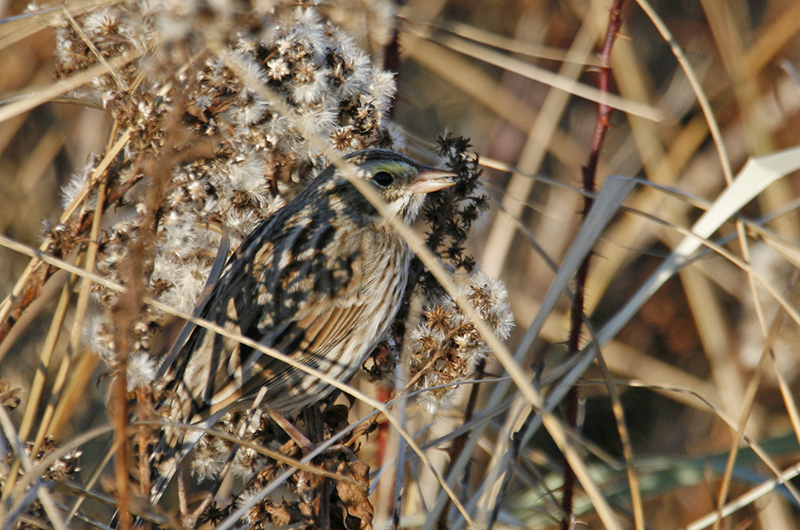We have been eagerly anticipating the arrival of the first ruby-throated hummingbirds. Four have shown up. Lisa Maxfield spotted the first of the season at her Oak Bluffs house on April 22; the next day, Gus Ben David spotted one at his Edgartown house; on April 24 Ann Richards and Gary Mirando saw their first hummingbird at their West Tisbury home; and John Nelson saw one the next day. As of Monday evening, everyone else is still anticipating their first sighting, but not to worry: a lot more hummingbirds will soon be here. Also eagerly anticipated are the spring migrant insect eaters. They are starting to arrive but, like the hummers, most will come in the next couple of weeks.
Allan Keith spotted a ruby-crowned kinglet on April 18 at Priester’s Pond and Shea Fee spotted one the same day at Wasque. Brian Vigorito found one black-and-white warbler at Felix Neck on April 18. On April 21 Wendy Culbert first heard and then saw a black-and-white warbler near our Vineyard Haven home. At Squibnocket on April 23, Allan Keith spotted three northern parulas, a white-eyed vireo and a ruby-crowned kinglet, as well as a blue-gray gnatcatcher at Sheriff’s Meadow Sanctuary. The blue-gray gnatcatcher I saw was in our front yard on April 25. On April 24, Margaret Curtin saw a black-and-white warbler and a northern parula along North Road near the boundary of Chilmark and West Tisbury.
Quoting Matt Pelikan: “There were a lot of yellow-rumped warblers around!” On April 18 Allan Keith spotted six at Priester’s Pond. On April 20, Travis Mazerall visited Long Point and observed a flock of 20. Walt Looney saw three on April 21 at Sheriff’s Meadow Sanctuary. At Long Point on April 24 Margaret Curtin and Nancy Weaver found five yellow-rumped warblers — the same day that Allan Keith spotted 12 at Squibnocket and I spotted three in the State Forest. That is more yellow-rumpeds than we have seen all winter. And soon they all will have headed northward back to their nesting grounds.
Pine warblers are also becoming more abundant. They are an early migrating warbler that nests on the Island. Walt Looney spotted two pine warblers at Sheriff’s Meadow Sanctuary on April 21 and eight more at Felix Neck on April 22, while Bridget Dunnigan and Sea Williams found seven in the northeastern state forest. On April 23, Shea Fee found six at Wasque and Lisa Maxfield saw one near Brush Pond. I saw six in the state forest on April 24. That same day, Will Stollsteimer saw four in the woods near the West Tisbury School and Nancy Weaver and Margaret Curtin spotted three at Long Point.
Swallows also are becoming more abundant. On April 18 Bob Shriber spotted six barn swallows and one northern rough-winged swallow in Aquinnah, while Brian Vigorito saw one barn swallow. Travis Mazerall saw one barn swallow mixed into a flock of 15 tree swallows on April 20 at Long Point. The next day Matthew Born spotted six barn swallows in Aquinnah and Warren Woessner spotted 10 at Squibnocket. The MV Bird Club found five barn swallows in Aquinnah on April 23, the same day I spotted a northern rough-winged swallow and a bank swallow in a small flock of seven tree swallows and two barn swallows. Margaret Curtin and Nancy Weaver found two barn swallows mixed in with six tree swallows at Long Point on April 24, the same day I observed a pair of tree swallows copulating on top of a nest box at the state forest headquarters. These four species all nest on the Island and will become more abundant as the season progresses.
One of my favorite birds is the whip-poor-will, the songster that repeatedly chants its name at dawn and dusk, and through the night on bright, full moon nights. Some people are less enchanted with them for that reason, even though they are nowhere near as common and widespread as they were 40 or more years ago. Shea Fee heard the first whip-poor-will of the year on April 21 at Wasque.
Perhaps the most interesting migrant to arrive this week is a first year red-headed woodpecker, carefully observed and studied by Margaret Curtin on April 18 near the northern end of Oyster Pond. This species is quite rare on the Island and is only seen a couple of times per year.
Allen Slater had an unexpected visitor — a rose-breasted grosbeak — at his Chappaquiddick feeder on April 21. This species is guaranteed to startle you with its black and while plumage and a rosy-red triangle on its chest.
Speaking of black and white, I spotted a solitary black skimmer as it arrived and perched amidst the gulls at Sarson’s Island on April 23. This elegant species — related to terns and gulls — is a popular sighting on Little Beach, the only site in Massachusetts where it nests. It will soon be easy to spot from the Eel Pond boat ramp at the end of Braley’s Way. There have been three indigo buntings spotted this week. Dorothy and John Dropick saw two at their feeders on April 21, and Ken Magnuson found one at the Edgartown Golf Club on April 23. There were three horned larks and three savannah sparrows spotted on Leland Beach (East Beach, just north of Wasque) on April 21, spotted by Shea Fee. The next day, she spotted a kestrel on East Beach. This latter sighting is the second kestrel seen this week; Anne Whiting and Tara Whiting-Wells spotted one at Quenames on April 21.
At least a dozen great egrets are roosting daily in the oak trees behind Daryl Knight’s house on Chappaquiddick. They have roosted there every spring and fall since about 2008, and are easy to see since the leaves are not yet obscuring this activity. Daryl Knight also reports that 50 gannets were plunge-diving in the ocean off Wasque on April 23 – a spectacular sight.
Nature is not always cheerful. Patsy Donovan reports that the raven nest in the tower next to the Verizon building blew down in the strong winds of April 19. Unfortunately, the four chicks did not survive. The pair had rebuilt the nest in the past month but it was not sturdy enough.
Maybe that is why we have had a number of sightings of ravens around the island this week, since the adults are no longer focused on their nest. Jerry Danzig spotted two ravens on Mayflower Lane on April 21 and Beldon Radcliffe has seen them along Lower Lambert’s Cove Road. Also on April 21, Shea Fee spotted two ravens at Mytoi and said “the crows were not happy to have them around.” On April 24 I observed two ravens being chased by crows near the state forest headquarters.
Finally, there are many other species reported this week but space is limited. These species include green-winged teal, bald eagle, peregrine falcon, Virginia rail, killdeer, more than 100 dunlin, 40 black-bellied plovers, 12 sanderlings, two short-billed dowitchers, greater yellowlegs, fish crow, red-breasted nuthatch, mockingbird, catbird, brown thrasher, hermit thrush, swamp sparrow, chipping sparrow, field sparrow, white-throated sparrow, dark-eyed junco and eastern towhee,
Please email your sightings to birds@mvgazette.com
Robert Culbert is an ecological consultant with Nature Watch LLC living in Vineyard Haven.











Comments
Comment policy »